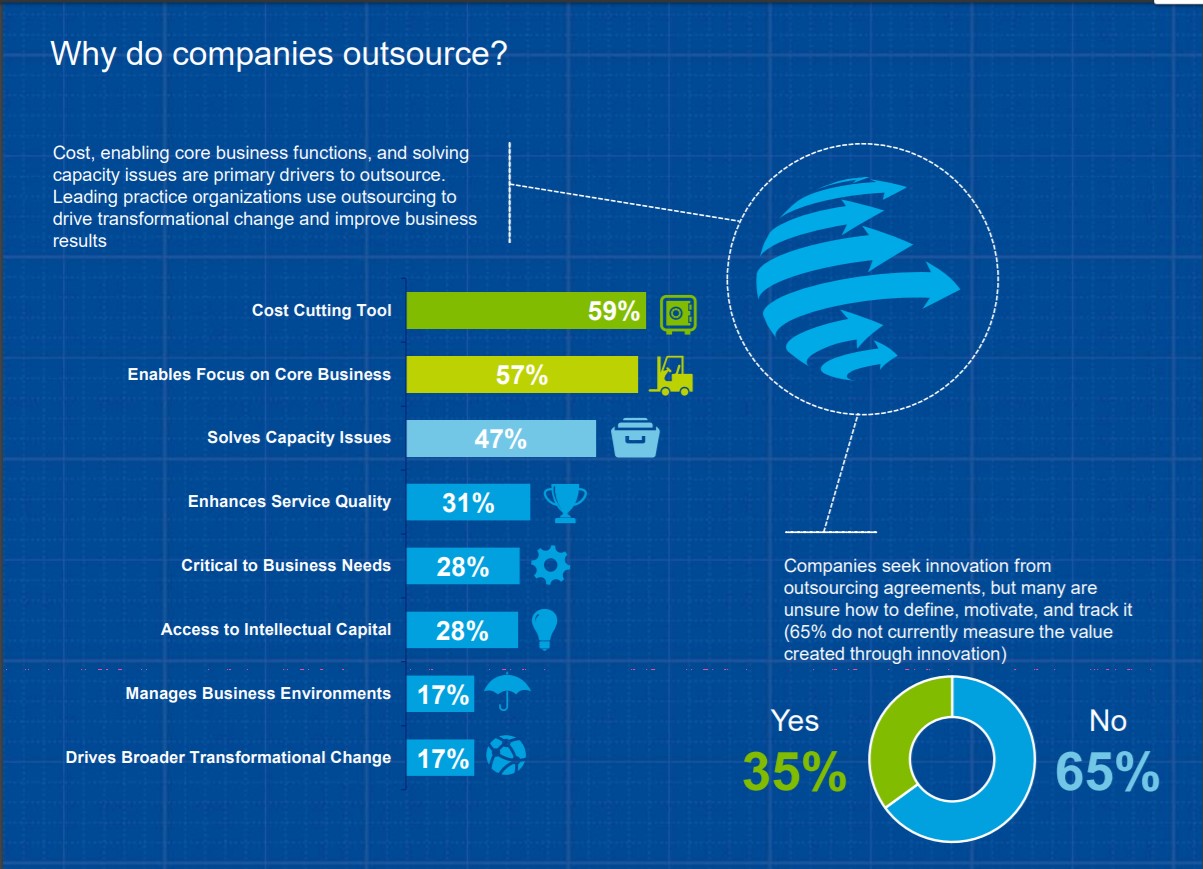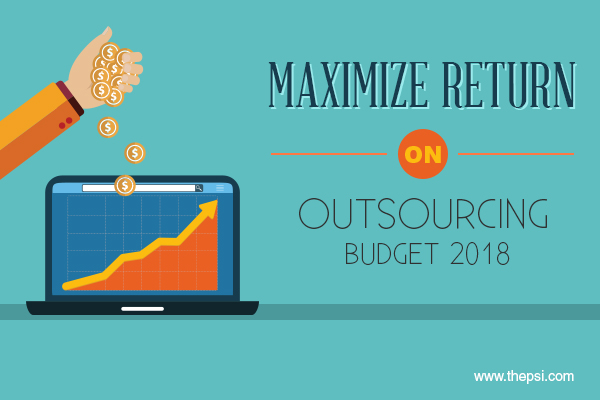Outsourcing has helped organizations across various sectors in improving their operations and returns. According to a Global Outsourcing Survey conducted by Deloitte, the biggest reason for businesses to outsource their operations is to cut costs. This was followed by the ability to focus on core business. So it’s no surprise that businesses can perform better and yield higher revenues when they outsource some of their process.
However, you may be looking for ways to further maximize the return on your outsourcing budget. It’s either because your current outsourcing efforts aren’t yielding the kind of returns you expected. Or it may be because your organization wants to grow exponentially and needs higher returns compared to your current ROI. There are several ways you can prepare to maximize the return on your outsourcing budget for 2018.
 Source: Deloitte
Source: Deloitte
Work on Improving Vendor Management Function
One of the first aspects you need to look at is how you run your Vendor Management. This is crucial because 43% of respondents in the Deloitte study reported significant savings resulting from the vendor management function. This is probably why 64% of organizations in the study are working to improve the capabilities of their Vendor Management Organization.
Does your Vendor Management Office work effectively in evaluating your third-party service providers? The unit needs to carefully supervise the day-to-day interactions carried out between your organization and the outsourced team in order to maintain long-term relationships.
If you don’t have one yet, you will need to establish an IT Vendor Management Office. This unit will monitor vendor relationships in relation to IT. It will also develop the perfect mix of in-sourcing and outsourcing opportunities in IT. The IT Vendor Management Office will also develop policies regarding vendor risk management.
In case your organization isn’t ready to develop a full-scale Vendor Management Office, you can still set up an IT governance body. This will be made up of employees to oversee your purchasing policies and make assessments of the new offerings and technologies of your vendors. It’s crucial that this governance body has broad representation from different departments such as IT, legal, procurement, etc.
Improve Your Service Transition Process
There is always room for improvement in any business – whether they outsource or not. Even in your case, identifying the opportunities for improvement and working on improving them can help in maximizing the return on your outsourcing budget. And according to the Deloitte study, organizations felt that the biggest opportunity for improvement was to spend more time in service transition.
The service transition process is necessary for aligning any changes in service with the requirements and operations of an organization. In other words, it enables organizations to plan and manage changes in services. There are several processes involved in service transition such as change management, knowledge management, management of IT service asset and configuration, management of release and deployment, change assessment, and service validation and testing.

With so many processes involved, it’s no wonder that many organizations feel the need to spend more time on service transition. If those involved in the process do not have sufficient knowledge or experience, the transition could fail miserably. This means a loss for your organization, which affects your outsourcing ROI.
You will need to set up a unit that oversees the changes occurring in the organization at every stage. This unit will ensure that there is smooth and effective implementation of the changes. By doing so, they will minimize risk and prevent any major errors from occurring. They will ensure that there is proper knowledge transfer across different teams.
Spend More Time on Vendor Selection
Another huge opportunity for improvement in outsourcing is in the vendor selection process. 28% of organizations in the Deloitte study felt that they should devote more time to the process. This makes sense because the process will determine the smoothness of their outsourcing operations and their ability to maximize their returns.
A thorough vendor selection process helps your organization in filtering out the least ideal vendors that could risk the profitability of your outsourcing operation. Some organizations may be drawn to affordability alone and make a rash decision to work with vendors whose quotes are the lowest. This could prove to be a disaster as there’s no promise of quality and reliability.
Instead, take your time to analyze all the proposals you get from prospective vendors. Look for vendors that best suit your business requirements and have a respectable portfolio. Only after short-listing the options you have after this should you start looking at the price. This will help you avoid working with cheap vendors who fail to deliver on their commitments and damage your outsourcing returns.
Audit Your Provider
After you’ve chosen a vendor to work with and you’ve carried out a few outsource processes with them, make sure you carry out an audit. Unfortunately, only 22% of respondents in the Deloitte study audited their provider and discovered material issue. Without an audit, you’re going to have a hard time understanding the root of your problems and the scope for improvements.
Conducting a regular and thorough audit of your outsourced service provider can help you determine the quality of your outsourced operations. You will be able to monitor the provider’s ability to comply with your contractual requirements and deliver the quality of service you had expected. Some of the basics you need to monitor are: speed of delivery, quality of finished product, responsiveness of staff, etc.
You should also consider to monitor factors such as how quickly the outsourced provider is able to resolve issues and how thoroughly they run tests before providing you with a finished product. Ideally, all of this would have been discussed and agreed upon before your vendor selection. But there’s a chance the provider doesn’t live up to their promises, which could result in a loss or a reduction of returns from outsourcing budget for you.
Conclusion
These steps can effectively help you in maximizing the return on your outsourcing budget for the coming year. It’s clear that there is a dire need for you to pay more attention to different processes of coordination to achieve better returns.
Here, the PSI helps in providing outsourcing solutions to all kind of development solutions and specialized in product development processes.
Outsourcing has helped organizations across various sectors in improving their operations and returns. According to a Global Outsourcing Survey conducted by Deloitte, the biggest reason for businesses to outsource their operations is to cut costs. This was followed by the ability to focus on core business. So it’s no surprise that businesses can perform better and yield higher revenues when they outsource some of their process.
However, you may be looking for ways to further maximize the return on your outsourcing budget. It’s either because your current outsourcing efforts aren’t yielding the kind of returns you expected. Or it may be because your organization wants to grow exponentially and needs higher returns compared to your current ROI. There are several ways you can prepare to maximize the return on your outsourcing budget for 2018.

Source: Deloitte
Work on Improving Vendor Management Function
One of the first aspects you need to look at is how you run your Vendor Management. This is crucial because 43% of respondents in the Deloitte study reported significant savings resulting from the vendor management function. This is probably why 64% of organizations in the study are working to improve the capabilities of their Vendor Management Organization.
Does your Vendor Management Office work effectively in evaluating your third-party service providers? The unit needs to carefully supervise the day-to-day interactions carried out between your organization and the outsourced team in order to maintain long-term relationships.
If you don’t have one yet, you will need to establish an IT Vendor Management Office. This unit will monitor vendor relationships in relation to IT. It will also develop the perfect mix of in-sourcing and outsourcing opportunities in IT. The IT Vendor Management Office will also develop policies regarding vendor risk management.
In case your organization isn’t ready to develop a full-scale Vendor Management Office, you can still set up an IT governance body. This will be made up of employees to oversee your purchasing policies and make assessments of the new offerings and technologies of your vendors. It’s crucial that this governance body has broad representation from different departments such as IT, legal, procurement, etc.
Improve Your Service Transition Process
There is always room for improvement in any business – whether they outsource or not. Even in your case, identifying the opportunities for improvement and working on improving them can help in maximizing the return on your outsourcing budget. And according to the Deloitte study, organizations felt that the biggest opportunity for improvement was to spend more time in service transition.
The service transition process is necessary for aligning any changes in service with the requirements and operations of an organization. In other words, it enables organizations to plan and manage changes in services. There are several processes involved in service transition such as change management, knowledge management, management of IT service asset and configuration, management of release and deployment, change assessment, and service validation and testing.

With so many processes involved, it’s no wonder that many organizations feel the need to spend more time on service transition. If those involved in the process do not have sufficient knowledge or experience, the transition could fail miserably. This means a loss for your organization, which affects your outsourcing ROI.
You will need to set up a unit that oversees the changes occurring in the organization at every stage. This unit will ensure that there is smooth and effective implementation of the changes. By doing so, they will minimize risk and prevent any major errors from occurring. They will ensure that there is proper knowledge transfer across different teams.
Spend More Time on Vendor Selection
Another huge opportunity for improvement in outsourcing is in the vendor selection process. 28% of organizations in the Deloitte study felt that they should devote more time to the process. This makes sense because the process will determine the smoothness of their outsourcing operations and their ability to maximize their returns.
A thorough vendor selection process helps your organization in filtering out the least ideal vendors that could risk the profitability of your outsourcing operation. Some organizations may be drawn to affordability alone and make a rash decision to work with vendors whose quotes are the lowest. This could prove to be a disaster as there’s no promise of quality and reliability.
Instead, take your time to analyze all the proposals you get from prospective vendors. Look for vendors that best suit your business requirements and have a respectable portfolio. Only after short-listing the options you have after this should you start looking at the price. This will help you avoid working with cheap vendors who fail to deliver on their commitments and damage your outsourcing returns.
Audit Your Provider
After you’ve chosen a vendor to work with and you’ve carried out a few outsource processes with them, make sure you carry out an audit. Unfortunately, only 22% of respondents in the Deloitte study audited their provider and discovered material issue. Without an audit, you’re going to have a hard time understanding the root of your problems and the scope for improvements.
Conducting a regular and thorough audit of your outsourced service provider can help you determine the quality of your outsourced operations. You will be able to monitor the provider’s ability to comply with your contractual requirements and deliver the quality of service you had expected. Some of the basics you need to monitor are: speed of delivery, quality of finished product, responsiveness of staff, etc.
You should also consider to monitor factors such as how quickly the outsourced provider is able to resolve issues and how thoroughly they run tests before providing you with a finished product. Ideally, all of this would have been discussed and agreed upon before your vendor selection. But there’s a chance the provider doesn’t live up to their promises, which could result in a loss or a reduction of returns from outsourcing budget for you.
Conclusion
These steps can effectively help you in maximizing the return on your outsourcing budget for the coming year. It’s clear that there is a dire need for you to pay more attention to different processes of coordination to achieve better returns.
Here, the PSI helps in providing outsourcing solutions to all kind of development solutions and specialized in product development processes.[:]









